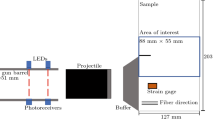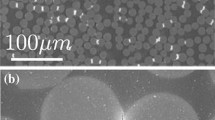Abstract
Carbon fiber/epoxy material in the form of a single fiber unidirectional composite was subjected to controlled humidity environments. Moisture uptake in polymer composites has significant effects on the mechanical properties of the matrix as well as on the final performance of the composite material. Diminishing of the mechanical properties of the matrix is attributed to a decrease of its glass transition temperature (T g). The quality of the fiber–matrix interphase was assessed using the single fiber fragmentation test and the fiber-fragment length, considered as an indicator of interfacial quality. In order to measure the fiber fragment lengths and indentify failure mechanism at the interface optical observation and acoustic emission technique were used. The speed of propagation of an acoustic wave in the material was also determined. A comparison is made of interfacial shear strength values determined by acoustic emission and optical techniques. Excellent agreement between the two techniques was obtained. By means of a micromechanical model, it was possible to determine from the fragmentation lengths a measure of the interfacial shear strength between the fiber and the matrix. The role of moisture uptake swelling of the matrix on the residual stresses is considered to be important when considering the effect deterioration of interfacial shear properties. Both the contribution of the radial stresses and the mechanical component of fiber–matrix adhesion are seen to decrease rapidly for higher moisture contents in the matrix and/or interface.














Similar content being viewed by others
References
Xiao GZ, Shanahan MER (1997) J Polym Sci B 3:2659
Pomies F, Carlsson LA (1994) J. Compos Mater 28:22
Adams DF (1986) A micromechanies analysis of the influence of the interface on the performance of polymer matrix composites. In: Proceedings of the American Society for composites, lst technical conference, 7–9 Oct. Technomic publishing, Dayton, p 207
Chateauminois A, Chabert B, Soulier JP, Vincent L (1995) Polym Comp 16:288
Soles CL, Chang FT, Gidley DW, Yee AF (2000) J Polym Sci B 38:776
Drzal LT, Rich MJ, Koenig MF (1985) Adhesion 18:49
Spragg CJ, Drzal LT (1996) Fiber, matrix and interface properties. ASTM STP no 1290. American Society for Testing and Materials, West Conshohocken
Netravali AN, Li ZF, Sachse WH, Wu HF (1990) In: Buckley JD (ed) Third conference on advanced engineering fibers and textile structure for composites. NASA conference publication 3082, Hampton, VA
Park JM, Chong EM, Dong JY, Lee JH (1998) Polym Comp 19:747
Nielsen LE, Landel RF (1994) Mechanical properties of polymers and composites. CRC Press, New York
ASTM (1985) Maintaining constant relative humidity by means of aqueous solutions. Book of ASTM standards, part 6. ASTM Designation E 104-85. American Society for Testing Materials, Philadelphia
Mijovic J, Lin KF (1985) J Appl Polym Sci 30:2527
Vanlandingham MR, Eduljee RF, Gillespie JW (1999) J Appl Polym Sci 71:787
Xiao GZ, Shanahan MER (1998) J Appl Polym Sci 69:363
Kolsky H (1963) Stress waves in solids. Dover Publications Inc., New York
Lu MG, Shim MJ, Kim SW (2001) J Appl Polym Sci 8:2253
Nogueira P, Ramirez C, Torres A, Abad MJ, Cano J, Lopez J, Lopez-Bueno I, Barral L (2001) J Appl Polym Sci 80:71
Rao V, Drzal LT (1991) Polym Compos 12:48
Adamson MJ (1980) J Mater Sci 15:1736. doi:https://doi.org/10.1007/BF00550593
Jackson ML, Love BJ, Hebner SR (1999) J Mater Sci Mater Electron 10:71
Xu ZR, Ashbee KHG (1994) J Mater Sci 29:394. doi:https://doi.org/10.1364/AO.29.000394
El-saad L, Darby MI, Yates B (1989) J Mater Sci 24:1653. doi:https://doi.org/10.1007/BF01105687
Ebrahimzadeh PR, Mcqueen DH (1998) J Mater Sci 33:1201. doi:https://doi.org/10.1023/A:1004373525437
Whitney JM, Drzal LT (1987) In: Johnston NJ (ed) ASTM STP 937 ASTM Committee D-30 on high modulus fibers and their composites, Philadelphia, USA
Acknowledgements
The authors wish to express the financial support from Consejo Nacional de Ciencia y Tecnología given through grant # 31272-U and for the scholarships granted to Mrs. Emilio Pérez Pacheco and Mr. Javier I. Cauich Cupul.
Author information
Authors and Affiliations
Corresponding author
Rights and permissions
About this article
Cite this article
Cauich-Cupul, J.I., Pérez-Pacheco, E., Valadez-González, A. et al. Effect of moisture absorption on the micromechanical behavior of carbon fiber/epoxy matrix composites. J Mater Sci 46, 6664–6672 (2011). https://doi.org/10.1007/s10853-011-5619-0
Received:
Accepted:
Published:
Issue Date:
DOI: https://doi.org/10.1007/s10853-011-5619-0




